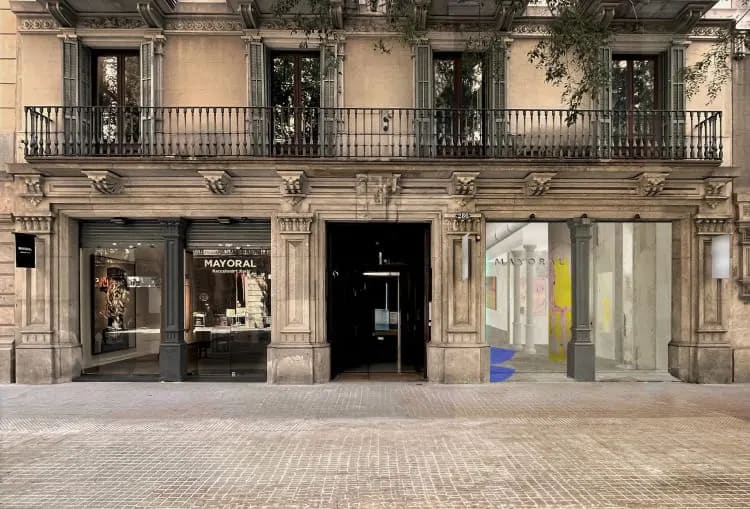HOW TO FOLD A PARACHUTE, a text by Joana Hurtado
JOANA HURTADO PRESENTS ALÍCIA VOGEL'S SOLO EXHIBITION AS PART OF ARTNOU FESTIVAL.
Jusqu’ici tout va bien. Jusqu’ici tout va bien. Jusqu’ici tout va bien.¹ With this kind of plea begins La haine (The Hate, 1995), a film by Mathieu Kassovitz that points a finger at the unease with which young people in the suburbs live. A film that has marked more than one generation and an iconic beginning, since this refrain in the form of a fallacious self-conviction, tells us a voice-over, is what a man repeats who throws himself from a fifty-story building, while in slow motion we see a Molotov cocktail heading towards the globe. Mais l’important, c’est pas la chute, c’est l’atterrissage,² and then everything explodes.
Showing or explaining all the details of the fall is what cinema usually does. Art always comes later. And in its decontextualization, the image loses drama and gains in nuances, in reflection, even in irony. Perhaps the most paradigmatic case is that of Rainer Maria Fassbinder’s elegant gangster who was shot and fell, also in slow motion, in Der Amerikanische Soldat (The American Soldier, 1970). The scene of that deadly dance became, in 1990, a triptych by Richard Prince that reflected on the underlying heroism in the American popular culture of the masculine ideal.
And after landing, what’s next? This is the question that Alícia Vogel asks us, with sarcasm. What happens when we have already fallen and nothing spectacular has happened? Has anything changed? Where is the fear of the before and during? These are also the questions we can ask ourselves as we fold the map after the journey. Or, rather, as we struggle to fold it following its original creases. An attempt that is in vain, because, although the map is the same, everything has changed. The journey, with its novelties and its wear and tear, makes neither it nor us able to return to where we were before we started. This is what Peter Handke tells us in Der Große Fall (The Great Fall, 2011), in an allegorical journey through the social and political fabric that weaves all the findings of the flâneur.
Nothing will be as before and yet, with each map, like with the duvet cover, a medication leaflet, or the sleeping bag, the scene is repeated and everything returns to being like the first time, but always different. Like the trace buried under layer after layer of paint, highlighting the tone and the nerve of the colour, the paradox lies in the process of breaking, cutting, and knotting a fragility that resists us, that from so much strength and gravity has been left in suspension. “It is the tension and serenity of the knots that assume their form once they cease to be rope; of the firm, orderly and bristly folds, turned into light, almost antagonistic papers, like crusts on the skin, which also accommodate in their place. A carousel of binomials that coexist in permeability”, Vogel writes.
In this making and unmaking the path, adding and removing weight, giving and receiving air, Vogel appropriates an old parachute to indicate the rawness and the tenderness of light things that can be lapidary. If it has been deployed, it means it has worked, but in the idea of folding it back there is a certain death drive, that path that undertakes, with more or less regularity and detours more or less short, the return to an inorganic state. The wings of the first person who tried to fly were of no use. And dealing with (more than one) shape to the success or failure of something in/voluntary is also the subject of Vogel’s video, a found footage film that stretches the black and white of Kassovitz up to Guy Debord and his In girum imus nocte et consumimur igni (1978), where the Latin palindrome points toward the alienating effects of capitalist society: “We wander in the night and we are consumed by fire”.
In a reverse journey to that of La haine, the crew of Interstellar (2014) move away from the world and time while we hear the verses of Dylan Thomas: Do not go gentle into that good night, / Old age should burn and rave at close of day; / Rage, rage against the dying of the light.³ Having reached the end, where does the rage go? At the end, Vogel does not rush. The moment of vertigo has passed. Without risk, without impact, without ballast, the only danger is that of returning to a balance that perhaps never existed. Perhaps landing on the ground again is this: to release, to untie, to fold back the parachute or the map with the certainty that there is nothing to learn.
After “How to Disappear Completely”, Alícia Vogel’s previous solo exhibition, “How to Fold a Parachute” is a new instruction for an old impossible that is almost tragicomic. Difficult to avoid the gaze when everything is looking at you, difficult to reconnect the dots when the coordinates multiply. What a handful. And now, what do we do with all this?
Joana Hurtado Matheu
June 21, 2024




